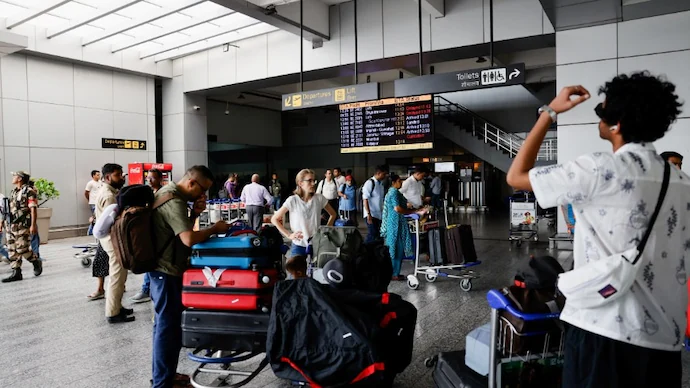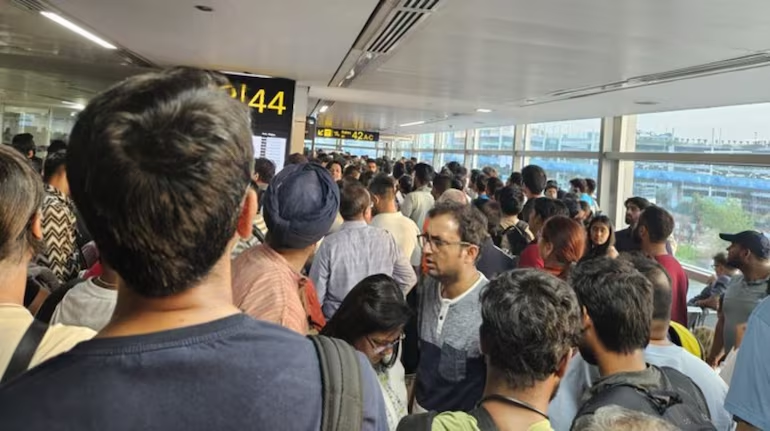
India’s aviation sector faced significant turbulence as rising Indo-Pak tensions led to the cancellation of 138 flights at Delhi’s Indira Gandhi International Airport (IGIA). This unprecedented disruption has affected thousands of travelers, further highlighting the wide-reaching implications of geopolitical conflicts.
A Day of Uncertainty for Air Travelers
On the morning of May 10, passengers at IGIA were met with a flurry of announcements detailing flight cancellations. The cancellations included 66 domestic departures, 63 domestic arrivals, five international departures, and four international arrivals. Airlines cited escalating tensions and associated airspace restrictions as the primary reasons for this operational chaos.
The cancellations not only left passengers stranded but also caused cascading delays across the aviation network. Travel plans were disrupted, business schedules thrown into disarray, and families left scrambling to rebook their flights.
The Geopolitical Context: Rising Tensions Between India and Pakistan
The root cause of this disruption lies in the escalating tensions between India and Pakistan, exacerbated by recent military operations and political stand-offs. India’s recent Operation Sindoor, a precision airstrike targeting terrorist networks in Pakistan, has heightened hostilities in the region. These military actions have compelled both nations to bolster their security measures, with Pakistan closing significant portions of its airspace and India enforcing stringent aviation protocols.
Delhi Airport’s Role in the Aviation Network
As one of Asia’s busiest airports, Delhi’s IGIA plays a critical role in India’s domestic and international connectivity. It serves as a hub for major airlines and handles millions of passengers annually. The sudden disruption at this key aviation node has had ripple effects, impacting flights across the country and beyond.
The cancellations at Delhi Airport reflect broader challenges faced by India’s aviation sector during times of geopolitical unrest. With air traffic heavily concentrated in northern India, airports in cities like Jaipur, Amritsar, and Chandigarh have also reported cancellations and delays, further straining the network.
Passenger Experiences: Struggles Amid Uncertainty
The impact on passengers has been severe. Travelers found themselves stuck at terminals, queuing at airline counters, and anxiously waiting for updates. Many expressed frustration over the lack of clear communication from airlines and airport authorities.
“I had an important meeting in Mumbai, and my flight was cancelled at the last minute. I wasn’t even notified until I reached the airport,” said a business traveler. Families traveling for weddings, vacations, or emergencies found themselves stranded, with limited options for alternative transportation.
Social media platforms have been flooded with complaints from passengers seeking clarity on rebookings and refunds. The aviation sector’s response to this crisis has been criticized as inadequate, with many calling for better contingency plans and customer support during such disruptions.
Impact on Domestic and International Airlines
Both domestic and international carriers have borne the brunt of these disruptions. Airlines such as IndiGo, Air India, and Vistara have had to reroute or cancel numerous flights. International carriers like Lufthansa and British Airways have also faced challenges, as airspace restrictions over Pakistan have forced them to take longer routes, increasing fuel costs and travel times.
“The situation is dynamic, and we are constantly monitoring developments to ensure passenger safety,” said a spokesperson for an international airline. However, the adjustments have not been without consequences, with passengers experiencing delays of up to several hours on long-haul flights.
Enhanced Security Measures at IGIA
Amid the aviation chaos, IGIA has ramped up its security protocols. Passengers have been subjected to thorough screening processes, with additional checks at entry points and terminals. Security personnel have been deployed in greater numbers, and surveillance measures have been intensified.
The Bureau of Civil Aviation Security (BCAS) has issued directives to ensure the safety of passengers and staff during this volatile period. While these measures are necessary, they have added to the delays and heightened tensions among travelers.
Broader Impact on Civil Aviation
The ripple effects of the disruptions at Delhi Airport have extended to other parts of the country. With airports in northern India facing similar challenges, airlines have struggled to maintain their schedules. Flights to and from smaller airports have been disproportionately affected, as resources are diverted to manage the crisis at larger hubs.
The ongoing situation has also raised questions about the resilience of India’s aviation infrastructure. Experts have called for better contingency planning and investments in technology to enhance the sector’s ability to respond to such crises.
Government Response and Coordination
The Indian government has taken several steps to address the situation. The Ministry of Civil Aviation has been in constant communication with airlines and airport authorities, urging them to prioritize passenger safety and provide timely updates. The government has also coordinated with security agencies to ensure that the heightened measures do not compromise operational efficiency.
The Ministry of External Affairs has issued advisories for travelers, urging caution and recommending alternative modes of transport where feasible. Meanwhile, the Ministry of Home Affairs has emphasized the importance of remaining vigilant and prepared for potential escalations.
International Reactions and Implications
The international community has been closely monitoring the developments in the region. Countries such as the United States and the United Kingdom have issued travel advisories for their citizens, urging them to exercise caution while traveling to India or Pakistan.
The situation has also prompted discussions about the broader implications of airspace restrictions. With key aviation routes passing through South Asia, the disruptions have highlighted the interconnected nature of global air travel and the need for international cooperation in managing crises.
Economic Fallout: Costs and Consequences
The financial impact of the flight cancellations has been significant. Airlines have incurred substantial losses due to the disruptions, with increased operational costs and reduced revenue from ticket sales. The hospitality and tourism sectors have also taken a hit, as travelers cancel their plans or postpone their trips.
Experts estimate that the economic fallout from this crisis could run into millions of dollars, with long-term consequences for the aviation and travel industries. The situation has underscored the vulnerability of these sectors to geopolitical events and the need for greater resilience.
Looking Ahead: Lessons and Recommendations
As the crisis continues to unfold, several lessons can be drawn from the current situation. First, there is a pressing need for better coordination between airlines, airports, and government agencies during times of crisis. Transparent communication and efficient management are crucial to minimizing disruptions and ensuring passenger confidence.
Second, investments in technology and infrastructure are essential to enhancing the resilience of India’s aviation sector. From advanced air traffic management systems to improved security protocols, the sector must be equipped to handle emerging challenges.
Finally, the crisis has highlighted the importance of contingency planning and scenario-based training for all stakeholders. Preparing for worst-case scenarios can help mitigate the impact of unforeseen events and ensure a swift response.
A Path to Recovery
Despite the challenges, there is hope for recovery. The aviation sector has demonstrated resilience in the face of past crises, and stakeholders are committed to addressing the current situation. Airlines are working to rebook passengers, enhance customer support, and resume normal operations as quickly as possible.
The government, too, is taking steps to restore confidence in the aviation sector. By addressing the root causes of the crisis and implementing long-term solutions, India can emerge stronger and better prepared for future challenges.
Conclusion
The cancellations at Delhi Airport have served as a stark reminder of the far-reaching implications of geopolitical tensions. As India navigates this challenging period, the resilience and determination of its people and institutions will be key to overcoming the crisis.
For now, passengers are urged to stay informed, remain patient, and cooperate with authorities. The collective efforts of all stakeholders will be crucial in ensuring a safe and swift recovery for India’s aviation sector.

